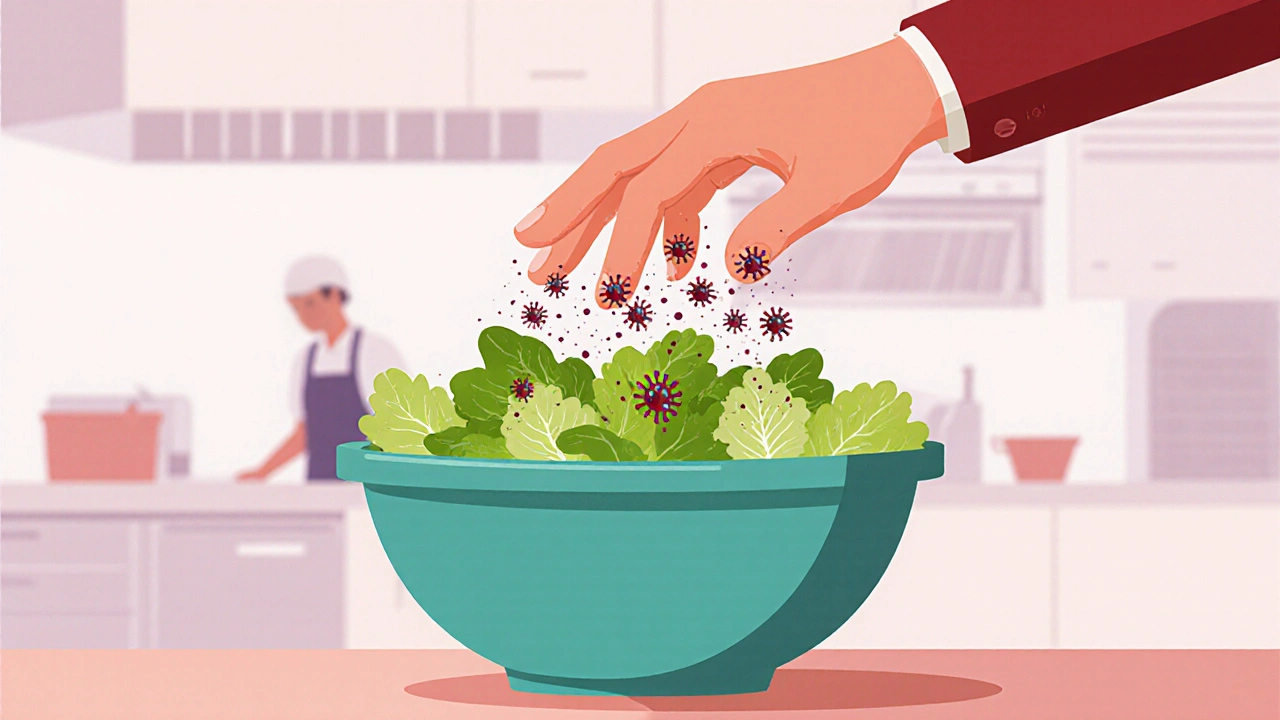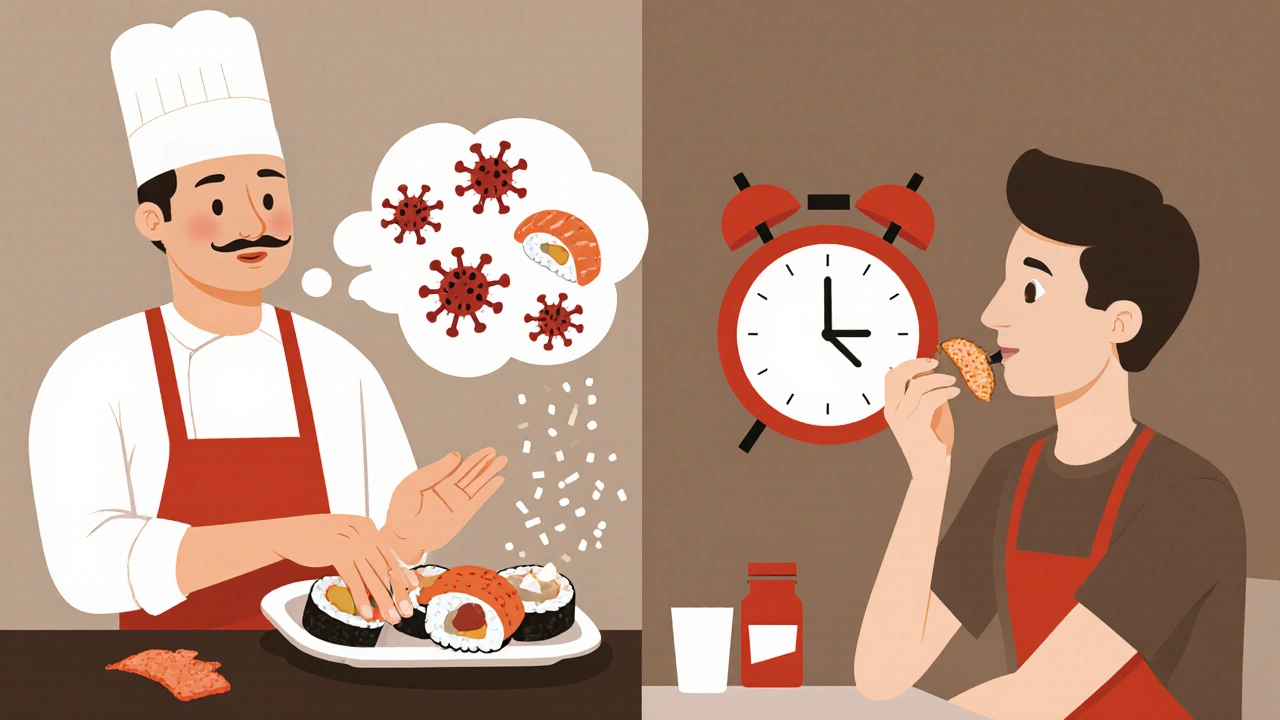Hepatitis A: How Food Spreads the Virus and What to Do After Exposure
 Nov, 16 2025
Nov, 16 2025
Most people think of hepatitis A as something you get from dirty water or bad hygiene. But in 2025, the biggest threat isn’t sewage - it’s your salad. Or your sushi. Or the sandwich made by someone who didn’t wash their hands after using the bathroom. Hepatitis A is one of the most contagious viruses on the planet, and it doesn’t need to be in water to spread. It just needs a single contaminated hand touching your food.
How Hepatitis A Moves From Person to Plate
The hepatitis A virus (HAV) is tiny, tough, and terrifyingly efficient. You only need 10 to 100 virus particles to get infected. That’s less than a speck of dust. It survives on surfaces for weeks, in frozen food for years, and even resists boiling water for a full minute. At 60°C, it’s still alive. Only when food hits 85°C for a full minute does the virus die.
Most outbreaks trace back to one source: an infected food worker. Studies show that nearly 10% of the virus on a contaminated finger can transfer to a piece of lettuce during casual contact. That’s not a lab guess - it’s measured science. And it’s why outbreaks often explode after a single person handles ready-to-eat food while infectious.
The scary part? Many infected people don’t feel sick right away. In fact, 30% to 50% of adults - and almost all children - show no symptoms at all. But they’re still shedding the virus in their stool. They can infect others for up to two weeks before they even feel ill. And they stay contagious for a full week after jaundice appears. That means someone can be spreading hepatitis A while thinking they’re just tired or have the flu.
Where the Virus Hides in Your Food
Shellfish are a classic culprit. They filter seawater - and if that water has even a little human waste, the virus gets trapped inside. The FDA says shellfish outbreaks happen when harvesting waters have more than 14 fecal coliforms per 100 milliliters. That’s not rare. In coastal areas, it happens more often than people realize.
But it’s not just seafood. Fresh produce - especially lettuce, berries, and herbs - is now the top source of outbreaks in the U.S. Why? Because they’re eaten raw. A single infected handler can contaminate hundreds of servings during prep. Frozen berries used in smoothies or yogurt bowls? They’ve caused outbreaks too. The virus doesn’t die in the freezer. It waits.
Even pre-packaged foods aren’t safe if handled bare-handed. A 2023 survey in Washington State found that 78% of restaurants still let workers touch ready-to-eat food with their fingers. Only 42% use gloves or tongs. That’s not negligence - it’s ignorance. Most workers don’t know the rules.
What Happens After You’re Exposed
If you’ve eaten food from a place linked to a hepatitis A outbreak, time is critical. Post-exposure prophylaxis (PEP) works - but only if you act fast. The CDC says you have 14 days from the day you ate the food to get protected. After that, it’s too late.
There are two options:
- Hepatitis A vaccine - one shot, long-term protection. Recommended for people aged 1 to 40. It starts working in days and gives you immunity for at least 25 years.
- Immune globulin (IG) - a shot of antibodies. Used for people over 40, pregnant women, or those with liver disease. It protects you for only 2 to 5 months.
Cost-wise, the vaccine is cheaper - $50 to $75. IG costs $150 to $300. But the real cost isn’t the shot. It’s the outbreak that follows if you don’t act. One investigation can cost $100,000 to $500,000. That’s why health departments rush to offer PEP after a known exposure.
Here’s the catch: getting the shot doesn’t mean you’re instantly safe. You still need to avoid bare-hand contact with food for six weeks. You still need to wash your hands. You’re not contagious anymore - but you can still accidentally spread it if you’re careless.

What Food Workers Must Do
If you’re a food handler and you’re diagnosed with hepatitis A, you’re done working - for at least two weeks. The rules vary by state. In Iowa, you can return after seven days from jaundice. In California, you must wait 14 days from the start of symptoms. Either way, you’re off the line until you’re no longer shedding the virus.
But here’s the broken part: most restaurants don’t screen their staff. Only 30% of food workers in the U.S. are vaccinated. In fast-food and seasonal jobs - where turnover hits 60% a year - it’s as low as 15%. Many workers don’t even know they’re at risk. Surveys show only 35% can list hepatitis A symptoms. Only 28% know PEP must be given within 14 days.
Training helps. Hands-on demos improve compliance by 65%. But only 31% of restaurants do them. Most just hand out a pamphlet. Language barriers make it worse. In big cities, 45% of kitchen staff don’t speak English well enough to understand safety rules. And 22% of places don’t even have enough handwashing stations.
How to Protect Yourself
You can’t control what a restaurant worker does. But you can control your own habits.
- Wash your hands with soap and water for at least 20 seconds before eating or preparing food. Water alone cuts risk by only 30%. Soap cuts it by 70%.
- Wash produce, even if it’s labeled “pre-washed.” Rinse under running water - don’t soak it.
- When eating out, ask if staff use gloves or utensils for ready-to-eat food. If they don’t, choose another place.
- Check if your local health department has posted outbreak alerts. Many post them online.
- If you’re over 40, have liver disease, or are immunocompromised, talk to your doctor about getting vaccinated - even if you’re not a food worker.
There’s a reason 14 U.S. states now require hepatitis A vaccination for food handlers. California’s 2022 law prevented 120 infections and saved $1.2 million. It’s not just a health move - it’s an economic one. For every $1 spent on vaccinating food workers, you save $3.20 in outbreak costs.

What’s Changing Now
The game is shifting. Instead of waiting for outbreaks, health agencies are trying to stop them before they start.
Some places are testing restaurant wastewater for hepatitis A. If the virus shows up, they can track it back to an infected worker - even before they get sick. Pilot programs are 89% accurate.
Point-of-care tests are in final trials. In five years, a restaurant might be able to test a worker’s saliva in five minutes and know if they’re infected.
Some cities are starting to tie vaccination status to food handler permits. If you want to work in a kitchen, you show proof of vaccination. Twenty-two U.S. jurisdictions already do this.
And incentives work. One study gave food workers a $50 bonus for getting vaccinated. Vaccination rates jumped 38 percentage points.
These aren’t futuristic ideas. They’re happening now. And they’re working.
Final Reality Check
Hepatitis A isn’t gone. It’s just hiding. In your salad. In your sushi. In the hands of someone who doesn’t know they’re sick. The vaccine works. The protocols work. But they only work if people use them.
If you’re exposed - act fast. Get the shot within 14 days. Don’t wait for symptoms. Don’t assume it’s not serious. Hepatitis A can shut down your liver for weeks. It can cost you your job, your savings, your peace of mind.
If you work with food - get vaccinated. Push your employer for training. Demand gloves. Demand handwashing stations. This isn’t just about you. It’s about the person who eats your food tomorrow.
There’s no magic fix. No miracle cure. Just clean hands, clean food, and a shot that lasts decades. That’s all it takes to stop a virus that’s been around for thousands of years.
Can you get hepatitis A from cooked food?
You can’t get hepatitis A from food cooked to 85°C for at least one minute - that kills the virus. But most outbreaks happen because food is handled before cooking or eaten raw. So even if the food is cooked, if someone with the virus touched it before cooking, you’re still at risk. Always wash produce, even if it’s going to be cooked.
How long does it take for hepatitis A symptoms to show?
Symptoms usually appear 28 days after exposure, but the range is 15 to 50 days. That’s why it’s so hard to trace outbreaks. Someone might eat contaminated food on Monday and not feel sick until next month. By then, they’ve already passed it to others.
Is the hepatitis A vaccine safe?
Yes. The hepatitis A vaccine has been used safely for over 25 years. Common side effects are mild - sore arm, headache, or low-grade fever. Serious reactions are extremely rare. It’s one of the safest vaccines available and provides protection for at least 25 years after one dose.
Do I need the vaccine if I’ve had hepatitis A before?
No. If you’ve had a confirmed hepatitis A infection, you’re immune for life. Your body builds natural antibodies that protect you from future infections. You don’t need the vaccine. But make sure your diagnosis was confirmed with a blood test - not just symptoms.
Can I get hepatitis A from my pet?
No. Hepatitis A only infects humans. You can’t catch it from dogs, cats, or any other animals. The virus is spread only through human feces. So while your pet might track dirt into the house, they’re not the source of infection.
What if I can’t afford the vaccine or immune globulin?
Public health departments often provide free or low-cost PEP after known outbreaks. If you’ve been exposed and can’t pay, contact your local health department immediately. They’re required to help. Also, many clinics offer sliding-scale fees. Don’t wait - timing matters more than cost.
Can you get hepatitis A more than once?
No. Once you recover from hepatitis A, your body develops lifelong immunity. You won’t get it again, even if you’re exposed to the virus later. This is why vaccination is so effective - it mimics natural immunity without the illness.
Is hepatitis A the same as hepatitis B or C?
No. Hepatitis A is spread through contaminated food or water. Hepatitis B and C spread through blood or bodily fluids - like needles, sex, or childbirth. HAV doesn’t cause chronic liver disease. B and C can. They’re different viruses, with different treatments and prevention methods.
Should I get tested for hepatitis A if I feel fine?
Only if you’ve had a known exposure. If you ate at a place linked to an outbreak, get tested for IgM antibodies - even if you feel fine. Many people don’t show symptoms but can still spread the virus. Testing helps public health teams stop outbreaks before they grow.
Can I go to work if I’ve been vaccinated after exposure?
Yes - but only if you’re not infected. The vaccine prevents illness if given within 14 days of exposure, but it doesn’t stop you from already being infected. If you’re already shedding the virus, you still need to stay home. Vaccination protects you from getting sick - not from spreading the virus if you were exposed before the shot.
For more information on local outbreaks or vaccination clinics, contact your state or local health department. The CDC also maintains a public database of recent hepatitis A alerts.

mike tallent
November 17, 2025 AT 01:43jalyssa chea
November 18, 2025 AT 03:18Julie Roe
November 19, 2025 AT 05:17John Wayne
November 20, 2025 AT 11:08Peter Stephen .O
November 21, 2025 AT 02:51Andrew Cairney
November 22, 2025 AT 00:42Joyce Genon
November 22, 2025 AT 04:57Gary Lam
November 22, 2025 AT 10:13vinod mali
November 23, 2025 AT 15:28Abdul Mubeen
November 24, 2025 AT 17:23